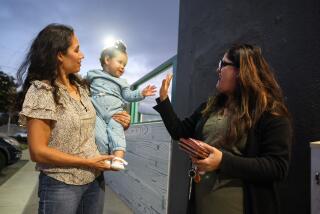New Outlook : Gift of Lenses Enables Surgeon to Renew Mission
- Share via
SAN JUAN CAPISTRANO — Since 1978, when he gave up his post-retirement gardening in Southern California to become a part-time “missionary doctor” in the rain forests of southeast Mexico, Dr. Theodore Whittington had made do without many essentials of his trade.
Sterile needles, local anesthetics, baby incubators, even scalpels, were in short supply as the Welsh-born surgeon sought to carry out what he calls “God’s work” at an eight-bed, makeshift hospital. Still, he worked with what he had.
About four years ago, Whittington discovered that he was losing a tool he thought could never be replaced, his eyesight.
On Monday, through the aid of the Center for the Partially Sighted in Santa Monica and local contributions, the 67-year-old Whittington was fitted for a pair of $1,000 “surgical telescopes” and declared himself ready to return to the operating room.
“They’re amazing,” Whittington said after testing out the lenses by picking up a needle from a table. “This means I can go back to doing surgery.”
Having spent an estimated $35,000 practicing medicine six months each year among the Mayan people in the rain forests, Whittington said he could not afford the spectacles, which can magnify objects up to 10 times. Officials at the Center for the Partially Sighted, impressed with his story, stepped in.
“When you hear about a guy dedicating his life like this to a cause, it’s impressive,” said Dr. Wayne Hoeft, a professor at the Southern California College of Optometry and a specialist in low-vision rehabilitation.
As a past district leader of Kiwanis International, Hoeft called several local Kiwanis groups--from Hollywood, Glendale and La Canada Flintridge--to help foot the bill for what is known technically as a “bioptic telescopic magnification device.”
Although the lenses have been around for about 30 years, Whittington had never heard of them until this year when he caught a late-night public service announcement. For the previous four years, as he gradually lost virtually all sight in his right eye and much of it in his left to a disease called macular degeneration, he struggled with remedies that proved ineffective.
He gave up surgery in the rain forest but practiced medicine there for six months every year, searching all the while for a way to go back to the operating table. Then he found the Santa Monica center and Hoeft.
Hoeft said Whittingham “won’t be doing any heart surgeries, but he can do a lot of things now that he couldn’t before and can see sharp and clear at a distance of 13 inches,” the distance needed to perform operations.
Whittington said the improvement in vision is--in the context of the operating room--the ability to distinguish between human tissue and a suture. By the time he stopped performing operations, he could not do that, he said.
The realization that he was losing his sight was grudging, Whittington said.
“You feel inadequate because your eyesight is failing,” he said. “You feel that if you can’t continue (as a surgeon), you’re letting people down.”
More to Read
Sign up for Essential California
The most important California stories and recommendations in your inbox every morning.
You may occasionally receive promotional content from the Los Angeles Times.













